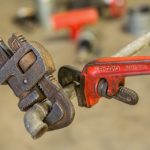
- The Roof – Start from the top and work your way down. The first thing you should check on your home is the roof. If you can, try to climb on to your roof, carefully of course, and examine it. Feel for spots that are softer than the rest. Look for dark areas where dirt or rain buildup occurs. Your roof should never have spots where leaves or sticks pile up. That is a danger zone for leaks. Make sure the flashings, the metal areas around chimneys and other protuberances, are present and tightly sealed. Keep a lookout for loose tiles and visible nail heads. If you can see the nail, then water can travel down it. Make sure all gutters are clean and suitable for drainage. Clogged gutters can mean standing water on your roof which can lead to leaks and water damage. Also check under overhangs for rotting wood, clogged attic vents, and signs of animal incursions. Animals, like squirrels and mice, can do a lot of damage to a home before you even know they are there. Seal up any holes or cracks to make sure your home is safe from invasion.
- The Siding – Once you have completed your inspection of the roof, then it is time to move on down. Most homes have siding, but even those homes with brick or other construction still need to be inspected. Look for cracks that can not only let in pests but can also be a sign of foundation issues. Feel the siding and look for soft spots, bulges, or discoloration that can be a sign of water damage that is hidden from view. Make sure the corners are not peeling or separating from the wall. The siding should be tight and compact, not loose or floppy. Loose siding can easily be caught by the wind in a storm and rip away from your house causing thousands of dollars in damage. Also look for wood rot and signs of termite damage. Catching it early can mean far less work and money invested later on. Make sure any exhaust vents, such as for the clothes dryer, are properly sealed and do not let in pests.
- The Foundation – Now you are down to the foundation. This is one of the most important parts of your home. Without a good foundation, the rest of your home will collapse. Foundation issues can be hard to see and often times we have to look for other evidence inside. However, I will get to that in a moment; for now you should look for cracking, settling or movement in your cement foundation. Make sure that there is nothing directly around your foundation. Large trees can cause root damage, bushes can attract pests and fire, and piles of junk can eat away at the dirt around your foundation. For homes not directly on a cement foundation you should get into the crawl space and make sure the home is securely stabilized. Make sure pests cannot live under the home and that the floor of the home is free from any water damage, large cracks or other discrepancies.
- The Yard –While you are still outside, take a look at your yard. What does your yard have to do with a home inspection? Sometimes quite a lot. You want your home to be the highest spot in your yard. Creating raised flower beds and other landscaping details can sometimes alter the flow of water and cause flooding or swampy-ness around your home. If you have a septic tank, make sure there is no damage to it and that the dirt and grass around it is not unusual as compared to the rest of the yard. Very green grass, damp soil or water retention are bad signs. Make sure all large trees are far enough from the home to avoid foundation damage or falling limbs. Tree limbs should never touch the roof of your home and any limbs that are dead should be cut off immediately. Keep a fire safety zone around your home by avoiding bushes and shrubbery near the home. This can also help your siding to avoid rot and make your home less appealing for burglary.
- The Attic – Now we go inside. Again, we want to start at the top. Go inside your attic and take a look around. The underside of the roof can help you to see water damage and leaks. Look for discolored spots, soft spots, or mold damage. Look at the insulation and make sure there is no damage there either. Pests can often destroy insulation to make nests. Your attic should not be too hot or too cold. If it is, then you may have an issue with ventilation. Your attic temperature determines how hard your home must work to stay a stable temperature so it is important. Take a look at any exposed wiring and look for frayed areas and melted or burned looking wires. This is very dangerous and MUST be addressed immediately. Walk around your attic, if possible, and inspect the ceiling of your home. Make sure everything looks solid and secure. If you have central heating or air in your attic, take a look at that too. Make sure that the drip pan is not full and any exhaust is properly ventilated. Duct work should be inspected to make sure holes are not present and all are securely fastened. Leaky air conditioners are the leading cause of water damaged ceilings. Also inspect any pipes, following along to look for possible leaks.
- The Ceiling –Moving down, inspect your home’s ceilings. Look for signs of water damage, cracks, bulges or peeling paint. Water damage and mold can be sneaky. You have to keep your eyes open. Look at heating and cooling vents. Dark areas around vents can mean dirty air ducts. Air ducts should be cleaned regularly both for performance and for safety reasons. Light fixtures and fans should be securely fastened and professionally installed. Never use a higher watt bulb then a fixture is approved for.
- The Walls –Now to the walls. The walls are often one of the first places you can see evidence of foundation issues. Cracks appearing in your walls mean that something is going wrong. You should also look for signs of leaky pipes or bad wiring. Touch the walls. If they are significantly hotter or cooler than the rest of your home, you could have a problem. Leaks can cause damp walls to grow mold and bad wiring can cause a series of small, nearly undetectable fires behind your walls. Loose light switches or electrical plugs are also a sign of wiring gone bad.
- The Doors and Windows – Another big indicator of foundation issues are doors and windows. Doors that do not shut properly, open at the slightest provocation and windows
with large cracks around the edges are all signs of foundation settling or cracking. In inspecting doors and windows you should make sure that any cracks or seams are properly sealed to ward off pests and drafts. Windows should be sealed where they connect also, especially if you do not often open them. Weather sealing can become brittle over time and need to be replaced. Doors should be sealed well, especially underneath. Even a quarter sized gap can admit all kinds of creepy crawlies. Make sure that all storm doors and window screens are secure. A strong wind can cause a lot of damage with unsecured items such as these. Warped or bent doors should be replaced and cracks in widows should be sealed before they spread. Oiling sliding doors and windows can prevent breakage and sticking later on and save you replacement costs. Make sure all moving parts are properly cleaned and oiled.
- The Floor – Bubbled, warping, or crooked floors are a bad sign. This can mean water damage or foundation issues. In many areas, such as bathrooms and kitchens, floors are subjected to corrosive things like water and oil. Make sure your flooring is proper for that area. For example, wood floors in a kitchen often absorb oil and become dirty and stained, unhealthy! Carpet or wood in bathrooms can hold moisture and create a breeding place for mold. Non-permeable surfaces, such as tile or linoleum, are preferred for those areas. Keep a look out for signs of pests as well. Mice pellets, small holes, signs of knawing, and dead bugs often mean a larger infestation. Make sure that pest control is high on your list of maintenance issues as they can cause significant damage. Upstairs, look for soft spots or low spots to prevent major issues.
- The Faucets – Last but not least we come to the culprit of much damage in the home. Leaky faucets and pipes cause millions of dollars in damage every year. Take a look at the faucets and pipes that are visible in your home. There should be no signs of rust or corrosion, no dampness and no leaks! Even a small leak can cause huge issues. Address any leaky piping immediately to prevent bigger problems later. Remember the toilet is a source of water damage as well, so make sure it is properly sealed. Inspect drains as well to assure they are flowing properly and not in danger of clogging or backing up.
You should perform a home inspection at least every six months and after every big storm. This can help your home to stay in tip top shape and prevent bigger problems from happening. Remember to inspect from top to bottom and do not ignore the small signs of a bigger issue. By dealing with issues while they are still small you can keep your home in shape without having to spend a lot of money to do so.
Author Byline:
This article is contributed by Madoline Hatter. Madoline is a freelance writer and blog junkie from ChangeOfAddressForm.com. You can reach her at: m.hatter12@gmail. com.







